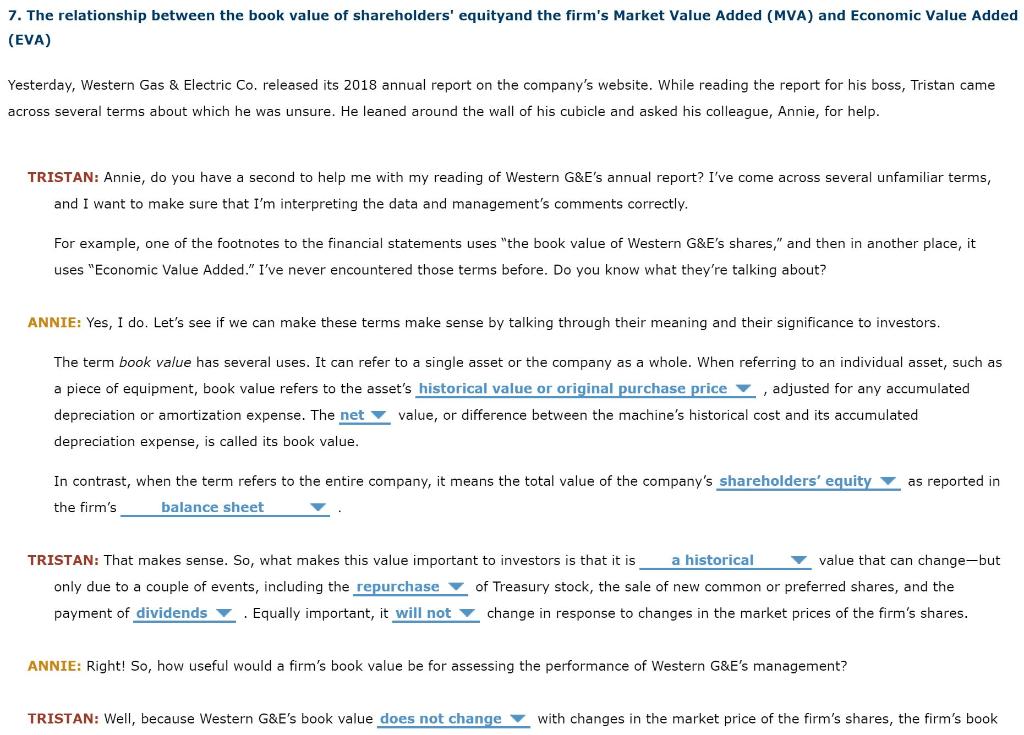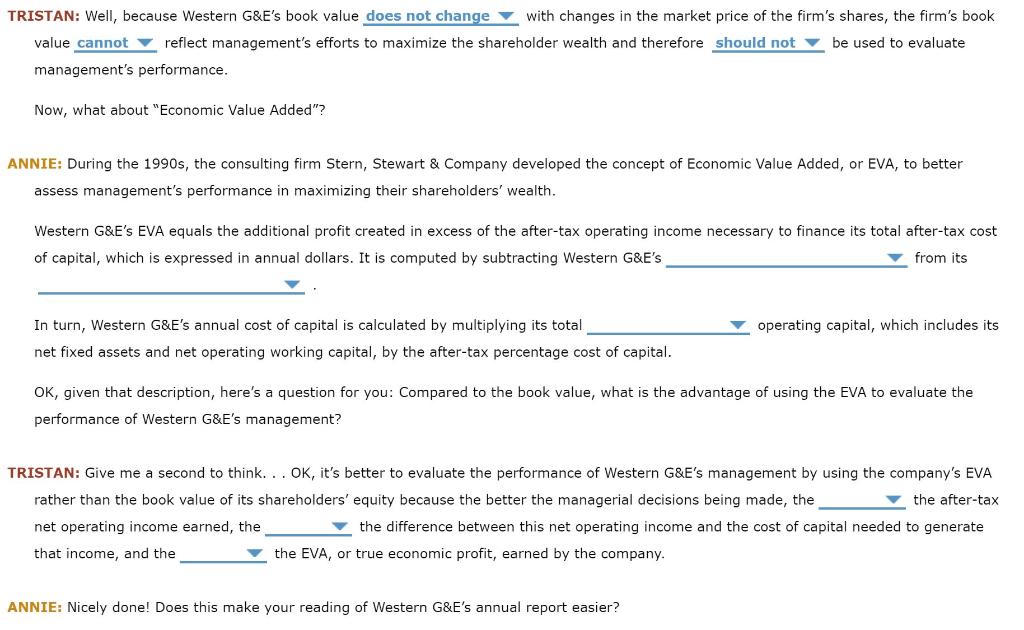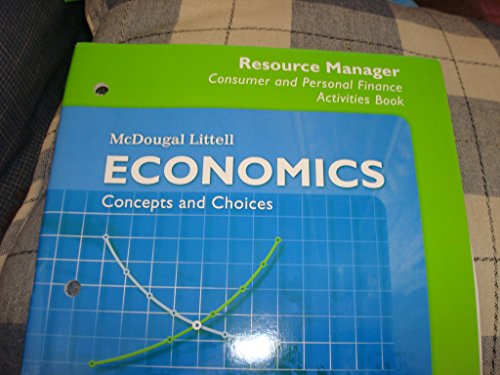Question
7. The relationship between the book value of shareholders' equityand the firm's Market Value Added (MVA) and Economic Value Added (EVA) Yesterday, Western Gas &


7. The relationship between the book value of shareholders' equityand the firm's Market Value Added (MVA) and Economic Value Added (EVA)
Yesterday, Western Gas & Electric Co. released its 2018 annual report on the companys website. While reading the report for his boss, Tristan came across several terms about which he was unsure. He leaned around the wall of his cubicle and asked his colleague, Annie, for help.
TRISTAN: Annie, do you have a second to help me with my reading of Western G&Es annual report? Ive come across several unfamiliar terms, and I want to make sure that Im interpreting the data and managements comments correctly.
For example, one of the footnotes to the financial statements uses the book value of Western G&Es shares, and then in another place, it uses Economic Value Added. Ive never encountered those terms before. Do you know what theyre talking about?
ANNIE: Yes, I do. Lets see if we can make these terms make sense by talking through their meaning and their significance to investors.
The term book value has several uses. It can refer to a single asset or the company as a whole. When referring to an individual asset, such as a piece of equipment, book value refers to the assetshistorical value or original purchase price , adjusted for any accumulated depreciation or amortization expense. Thenet value, or difference between the machines historical cost and its accumulated depreciation expense, is called its book value.
In contrast, when the term refers to the entire company, it means the total value of the companysshareholders equity as reported in the firmsbalance sheet .
TRISTAN: That makes sense. So, what makes this value important to investors is that it isa historical value that can changebut only due to a couple of events, including therepurchase of Treasury stock, the sale of new common or preferred shares, and the payment ofdividends . Equally important, itwill not change in response to changes in the market prices of the firms shares.
ANNIE: Right! So, how useful would a firms book value be for assessing the performance of Western G&Es management?
TRISTAN: Well, because Western G&Es book valuedoes not change with changes in the market price of the firms shares, the firms book valuecannot reflect managements efforts to maximize the shareholder wealth and therefore should not be used to evaluate managements performance.
Now, what about Economic Value Added?
ANNIE: During the 1990s, the consulting firm Stern, Stewart & Company developed the concept of Economic Value Added, or EVA, to better assess managements performance in maximizing their shareholders wealth.
Western G&Es EVA equals the additional profit created in excess of the after-tax operating income necessary to finance its total after-tax cost of capital, which is expressed in annual dollars. It is computed by subtracting Western G&Es from its .
In turn, Western G&Es annual cost of capital is calculated by multiplying its total operating capital, which includes its net fixed assets and net operating working capital, by the after-tax percentage cost of capital.
OK, given that description, heres a question for you: Compared to the book value, what is the advantage of using the EVA to evaluate the performance of Western G&Es management?
TRISTAN: Give me a second to think. . . OK, its better to evaluate the performance of Western G&Es management by using the companys EVA rather than the book value of its shareholders equity because the better the managerial decisions being made, the the after-tax net operating income earned, the the difference between this net operating income and the cost of capital needed to generate that income, and the the EVA, or true economic profit, earned by the company.
ANNIE: Nicely done! Does this make your reading of Western G&Es annual report easier?
*****
NOT SURE of the answers above
7. The relationship between the book value of shareholders' equityand the firm's Market Value Added (MVA) and Economic Value Added (EVA) Yesterday, Western Gas & Electric Co. released its 2018 annual report on the company's website. While reading the report for his boss, Tristan came across several terms about which he was unsure. He leaned around the wall of his cubicle and asked his colleague, Annie, for help. TRISTAN: Annie, do you have a second to help me with my reading of Western G&E's annual report? I've come across several unfamiliar terms, and I want to make sure that I'm interpreting the data and management's comments correctly. For example, one of the footnotes to the financial statements uses "the book value of Western G&E's shares," and then in another place, it uses "Economic Value Added." I've never encountered those terms before. Do you know what they're talking about? ANNIE: Yes, I do. Let's see if we can make these terms make sense by talking through their meaning and their significance to investors. The term book value has several uses. It can refer to a single asset or the company as a whole. When referring to an individual asset, such as a piece of equipment, book value refers to the asset's historical value or original purchase price, adjusted for any accumulated value, or difference between the machine's historical cost and its accumulated depreciation or amortization expense. The net depreciation expense, is called its book value. In contrast, when the term refers to the entire company, it means the total value of the company's shareholders' equity as reported in the firm's balance sheet TRISTAN: That makes sense. So, what makes this value important to investors is that it is a historical value that can change-but only due to a couple of events, including the repurchase of Treasury stock, the sale of new common or preferred shares, and the payment of dividends. Equally important, it will not change in response to changes in the market prices of the firm's shares. ANNIE: Right! So, how useful would a firm's book value be for assessing the performance of Western G&E's management? TRISTAN: Well, because Western G&E's book value does not change with changes in the market price of the firm's shares, the firm's book TRISTAN: Well, because Western G&E's book value does not change with changes in the market price of the firm's shares, the firm's book value cannot reflect management's efforts to maximize the shareholder wealth and therefore should not be used to evaluate management's performance. Now, what about "Economic Value Added"? ANNIE: During the 1990s, the consulting firm Stern, Stewart & Company developed the concept of Economic Value Added, or EVA, to better assess management's performance in maximizing their shareholders' wealth. Western G&E's EVA equals the additional profit created in excess of the after-tax operating income necessary to finance its total after-tax cost of capital, which is expressed in annual dollars. It is computed by subtracting Western G&E's from its In turn, Western G&E's annual cost of capital is calculated by multiplying its total operating capital, which includes its net fixed assets and net operating working capital, by the after-tax percentage cost of capital. OK, given that description, here's a question for you: Compared to the book value, what is the advantage of using the EVA to evaluate the performance of Western G&E's management? TRISTAN: Give me a second to think... OK, it's better to evaluate the performance of Western G&E's management by using the company's EVA rather than the book value of its shareholders' equity because the better the managerial decisions being made, the the after-tax net operating income earned, the the difference between this net operating income and the cost of capital needed to generate that income, and the the EVA, or true economic profit, earned by the company. ANNIE: Nicely done! Does this make your reading of Western G&E's annual report easier? 7. The relationship between the book value of shareholders' equityand the firm's Market Value Added (MVA) and Economic Value Added (EVA) Yesterday, Western Gas & Electric Co. released its 2018 annual report on the company's website. While reading the report for his boss, Tristan came across several terms about which he was unsure. He leaned around the wall of his cubicle and asked his colleague, Annie, for help. TRISTAN: Annie, do you have a second to help me with my reading of Western G&E's annual report? I've come across several unfamiliar terms, and I want to make sure that I'm interpreting the data and management's comments correctly. For example, one of the footnotes to the financial statements uses "the book value of Western G&E's shares," and then in another place, it uses "Economic Value Added." I've never encountered those terms before. Do you know what they're talking about? ANNIE: Yes, I do. Let's see if we can make these terms make sense by talking through their meaning and their significance to investors. The term book value has several uses. It can refer to a single asset or the company as a whole. When referring to an individual asset, such as a piece of equipment, book value refers to the asset's historical value or original purchase price, adjusted for any accumulated value, or difference between the machine's historical cost and its accumulated depreciation or amortization expense. The net depreciation expense, is called its book value. In contrast, when the term refers to the entire company, it means the total value of the company's shareholders' equity as reported in the firm's balance sheet TRISTAN: That makes sense. So, what makes this value important to investors is that it is a historical value that can change-but only due to a couple of events, including the repurchase of Treasury stock, the sale of new common or preferred shares, and the payment of dividends. Equally important, it will not change in response to changes in the market prices of the firm's shares. ANNIE: Right! So, how useful would a firm's book value be for assessing the performance of Western G&E's management? TRISTAN: Well, because Western G&E's book value does not change with changes in the market price of the firm's shares, the firm's book TRISTAN: Well, because Western G&E's book value does not change with changes in the market price of the firm's shares, the firm's book value cannot reflect management's efforts to maximize the shareholder wealth and therefore should not be used to evaluate management's performance. Now, what about "Economic Value Added"? ANNIE: During the 1990s, the consulting firm Stern, Stewart & Company developed the concept of Economic Value Added, or EVA, to better assess management's performance in maximizing their shareholders' wealth. Western G&E's EVA equals the additional profit created in excess of the after-tax operating income necessary to finance its total after-tax cost of capital, which is expressed in annual dollars. It is computed by subtracting Western G&E's from its In turn, Western G&E's annual cost of capital is calculated by multiplying its total operating capital, which includes its net fixed assets and net operating working capital, by the after-tax percentage cost of capital. OK, given that description, here's a question for you: Compared to the book value, what is the advantage of using the EVA to evaluate the performance of Western G&E's management? TRISTAN: Give me a second to think... OK, it's better to evaluate the performance of Western G&E's management by using the company's EVA rather than the book value of its shareholders' equity because the better the managerial decisions being made, the the after-tax net operating income earned, the the difference between this net operating income and the cost of capital needed to generate that income, and the the EVA, or true economic profit, earned by the company. ANNIE: Nicely done! Does this make your reading of Western G&E's annual report easierStep by Step Solution
There are 3 Steps involved in it
Step: 1

Get Instant Access to Expert-Tailored Solutions
See step-by-step solutions with expert insights and AI powered tools for academic success
Step: 2

Step: 3

Ace Your Homework with AI
Get the answers you need in no time with our AI-driven, step-by-step assistance
Get Started


